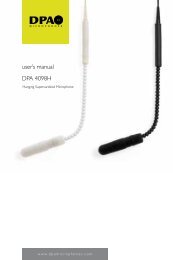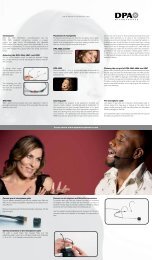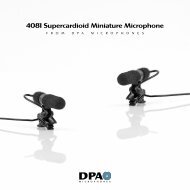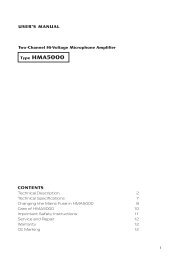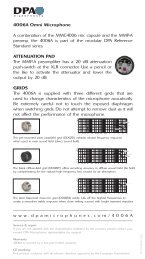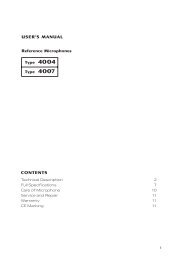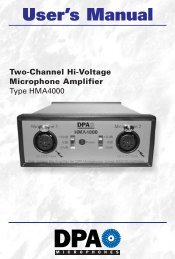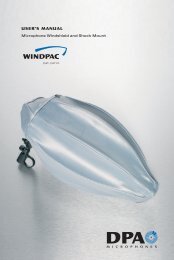DPA 4006 | PDF - DPA Microphones
DPA 4006 | PDF - DPA Microphones
DPA 4006 | PDF - DPA Microphones
You also want an ePaper? Increase the reach of your titles
YUMPU automatically turns print PDFs into web optimized ePapers that Google loves.
User’s Manual<br />
Omnidirectional <strong>Microphones</strong><br />
<strong>DPA</strong> 4003<br />
<strong>DPA</strong> <strong>4006</strong><br />
<strong>DPA</strong> <strong>4006</strong>-TL<br />
Included in kit solutions<br />
<strong>DPA</strong> 3503<br />
<strong>DPA</strong> 3530-A<br />
<strong>DPA</strong> 3506
User’s Manual<br />
Omnidirectional <strong>Microphones</strong><br />
<strong>DPA</strong> 4003<br />
<strong>DPA</strong> <strong>4006</strong><br />
<strong>DPA</strong> <strong>4006</strong>-TL<br />
Included in kit solutions<br />
<strong>DPA</strong> 3503<br />
<strong>DPA</strong> 3530-A<br />
<strong>DPA</strong> 3506<br />
Contents<br />
Technical Description 4<br />
Full Specifications 14<br />
Care of Microphone 19<br />
Service and Repair<br />
<br />
Warranty<br />
<br />
CE Marking<br />
<br />
Environmental Policy
Technical Description<br />
The cartridge<br />
<strong>DPA</strong> 4003 and <strong>4006</strong> are omnidirectional (pressure) microphones that use a 16<br />
mm diameter prepolarized condenser cartridge. The cartridge has low self noise<br />
(typical 15 dB(A) re. 20 µPa) and high sensitivity (4003 and <strong>4006</strong>-TL: 40 mV/Pa<br />
and <strong>4006</strong>: 10 mV/Pa). For optimum stability the microphone cartridges have<br />
undergone a special pre-aging process which stabilizes all tensions in the materials<br />
as well as the polarization voltage.<br />
The preamplifiers<br />
<strong>DPA</strong> 4003, <strong>4006</strong> and <strong>4006</strong>-TL are acoustically identical, but differ in their preamplifier<br />
powering system. The 4003 is powered with 130 V via the HMA5000<br />
High-Voltage Microphone Amplifier and has a modified 4-pin XLR-connector (see<br />
Fig. 1 for pin designation). This special powering system enables the microphone<br />
preamplifier to handle approximately 10 dB higher SPL than similar microphone<br />
types powered through conventional P48 systems (4003: 154 dB SPL peak and<br />
<strong>4006</strong>: 143 dB SPL peak). Furthermore, the 4003 together with the HMA5000<br />
is a totally transformerless system and therefore has an extended low-frequency<br />
handling capability (10 Hz to 20 kHz ± 2 dB). The <strong>4006</strong> is powered via a standard<br />
P48 system and is equipped with a standard 3-pin XLR-connector (see Fig.<br />
2 for pin designation). <strong>DPA</strong> 4003 and <strong>4006</strong> use state of the art low-noise preamplifier<br />
technology. The preamplifiers are driven with unity gain to keep noise<br />
as low as possible.<br />
The <strong>4006</strong>-TL is equipped with a state-of-the-art transformerless preamaplifier.<br />
All components in this construction are very carefully selected to fulfil the demand<br />
for optimal neutral timbre, tight and focused imaging and extremely low distortion<br />
even at very high sound pressure levels. The transformerless design has an<br />
extended low frequency handling capability (10 Hz to 20 kHz ±2 dB).<br />
The <strong>4006</strong>-TL is powered via a standard 48 V Phantom Power supply and has<br />
a standard 3-pin XLR connector. See Fig. 3 for pin designation. The output is<br />
impedance balanced between pin 2 and pin 3, with pin 2 carrying the signal.<br />
An attenuator is applied in the output amplifier to prevent overloading of input<br />
sections in the following equipment such as mixing consoles etc. When the button<br />
is pushed in, the output is attenuated by 20 dB.<br />
All microphones come with an individual calibration chart of the selfnoise, sensitivity<br />
and individual frequency response.
130 V DC<br />
Preamplifier Supply<br />
3<br />
2<br />
Signal<br />
4<br />
1<br />
Ground<br />
Fig. 1. External view of the output connector of the <strong>DPA</strong> 4003.<br />
Important:<br />
The microphone will only operate within it's specifications if<br />
powered correctly.<br />
Signal -<br />
Signal +<br />
Ground<br />
Fig. 2. External view of the output connector of the <strong>DPA</strong> <strong>4006</strong> and <strong>4006</strong>-TL.<br />
Signal -<br />
-20 0<br />
Signal +<br />
Ground<br />
Fig. 3. The switch on the XLR-connector of <strong>DPA</strong> <strong>4006</strong>-TL is used to select<br />
between 0 dB and 20 dB attenuation. Switch pressed in results in 20 dB<br />
attenuation.
The Free-field Grid, Silver<br />
The DD0251 Free-field Grid on the microphone cartridge is designed<br />
to have a linear on-axis frequency response for near-field applications<br />
(see Fig. 3 for frequency responses measured with the Free-field<br />
Grid). The grid is factory mounted but can be exchanged with the<br />
DD0297 Diffuse-field Grid or the UA0777 Nose Cone. Please be extremely careful<br />
not to touch the exposed diaphragm when changing the grids.<br />
The Diffuse-field Grid, Black<br />
The DD0297 Diffuse-field Grid is supplied as standard. It is<br />
designed for diffuse-field recordings, or recordings in the far field.<br />
The grid gives a high-frequency boost on-axis of 6 dB around 15<br />
kHz (see Fig. 5) without adding noise to the recording. This boost<br />
gives a linear diffuse-field (far field) response up to 15 kHz.<br />
The Close-miking Grid, Trapezoid, Silver<br />
The DD0254 Close-miking Grid is available as an optional<br />
accessory. Due to its high frequency roll-off (beginning at 12<br />
kHz and -3 dB at 20 kHz) it is designed to provide a soft<br />
and smooth high-end response, especially suitable for close<br />
miking applications. The response is altered acoustically without adding<br />
any noise or distortion. See Fig. 6 for frequency response.<br />
The Nose Cone, Trapezoid<br />
The UA0777 Nose Cone is available as an optional accessory.<br />
As with the DD0297 Diffuse-field Grid, the Nose Cone is simply<br />
screwed onto the microphone cartridge in place of the DD0251<br />
Free-field Grid. When fitted, the Nose Cone gives the microphone a<br />
true omnidirectional response even at high frequencies (see Fig. 7) and a linear<br />
diffuse-field response (see Fig. 5). These qualities are useful at any distance for<br />
an even tonal balance of sound arriving at all angles of incidence, e.g. room<br />
reverberation or several sound sources placed around the microphone. The<br />
diaphragm is placed in a slot behind the solid cone and sound waves only<br />
have access to the diaphragm through the side of the Nose Cone. This way the<br />
Nose Cone prevents an on-axis, high frequency sound pressure build-up on the<br />
microphone, which is the reason for normal flat fronted omnidirectional microphones<br />
becoming more and more directional for higher frequencies. There is,<br />
however, a slight high frequency boost on axis.<br />
6
Acoustic Pressure Equalizers<br />
Available as optional acoustical attachments are also the APEs – Acoustic<br />
Pressure Equalizers. The APEs use diffraction to passively modify the sound field<br />
near the microphone diaphragm, thus changing the microphone’s frequency<br />
response and, in particular, the polar response (see Fig. 14 and Fig. 15) without<br />
adding any electrical noise to the recording. The size and shape of the APE<br />
determines the acoustical changes of the microphone. The APEs are precision<br />
made from a special compact nylon material and will only fit the <strong>DPA</strong> 4003<br />
and <strong>4006</strong>/<strong>4006</strong>-TL fitted with the standard DD0251 Free-field Grid. There are<br />
four different APEs in the range: L30B is a Ø30 mm ball-shaped APE marked<br />
with a blue dot, L40B is a Ø40 mm ball-shaped APE marked with a green dot,<br />
L50B is a Ø50 mm ball-shaped APE marked with a red dot. The APEs can be<br />
obtained seperately or in the APE L6 Acoustic Modification kit. See Fig. 17 for<br />
how to mount the APEs on the microphone.<br />
The Passive Connection Converter<br />
The PCC4000 Passive Connection Converter is an optional accessory that makes<br />
it possible to run High-Voltage <strong>Microphones</strong> on standard 48 V phantom power<br />
with reduced microphone specs. The maximum reduction of the microphone<br />
SPL handling capability will be 13 dB and it is possible to drive up to 100 m<br />
(328 ft) of cable with the PCC4000 with the same specifications. Like the High-<br />
Voltage <strong>Microphones</strong> the PCC4000 is transformerless. The input connector is a<br />
modified 4-pin female XLR for connection directly to the microphone. The output<br />
is a standard 3-pin male XLR-connector for connection to standard cables.<br />
7
Fig. 4. On-axis and diffuse-field responses of <strong>DPA</strong> 4003, <strong>4006</strong> and <strong>4006</strong>-TL<br />
with the Free-field Grid DD0251 fitted.<br />
Fig. 5. On-axis and diffuse-field responses of <strong>DPA</strong> 4003, <strong>4006</strong> and <strong>4006</strong>-TL with<br />
the Diffuse-field Grid DD0297 fitted.<br />
Fig. 6. On-axis response of <strong>DPA</strong> 4003, <strong>4006</strong> and <strong>4006</strong>-TL with<br />
Close-miking Grid DD0254.<br />
8
25<br />
dB<br />
20<br />
15<br />
10<br />
5<br />
5 dB<br />
Diffuse<br />
0 10 20 Hz 50 100 200 500 1 kHz 2 5 10 20 40 D A B C Lin.<br />
Fig. 7. Diffuse-field response of <strong>DPA</strong> 4003, <strong>4006</strong> and <strong>4006</strong>-TL with UA0777 Nose<br />
Cones fitted.<br />
5 dB<br />
20 kHz<br />
15 kHz<br />
10 kHz<br />
5 kHz<br />
1 kHz<br />
Fig. 8 Directional characteristics of <strong>DPA</strong> 4003, <strong>4006</strong> and <strong>4006</strong>-TL with the<br />
DD0297 Diffuse-field Grid fitted (normalized).<br />
20 kHz<br />
15 kHz<br />
10 kHz<br />
5 kHz<br />
1 kHz<br />
Fig. 9. Directional characteristics of <strong>DPA</strong> 4003, <strong>4006</strong> and <strong>4006</strong>-TL with DD0254<br />
Close-miking Grid (normalized).
18 kHz<br />
10 kHz<br />
8 kHz<br />
4 kHz<br />
1 kHz<br />
20 kHz<br />
14 kHz<br />
10 dB<br />
Fig. 10. Directional characteristics of <strong>DPA</strong> 4003, <strong>4006</strong> and <strong>4006</strong>-TL with UA0777<br />
Nose Cone fitted (normalized).<br />
dB<br />
10<br />
20<br />
Amplitude<br />
10 dB<br />
30<br />
40<br />
50<br />
60<br />
Phase<br />
90°<br />
70<br />
5 kHZ 50 kHz<br />
80<br />
Fig. 11. On-axis amplitude and phase responses of <strong>DPA</strong> 4003, <strong>4006</strong> and <strong>4006</strong>-TL<br />
plotted using a linear frequency axis for evaluation of the phase response.<br />
10
Phase<br />
90º<br />
0º<br />
-90º<br />
0 5 10 15 20 25 30 35 40 45 50 kHz<br />
Fig. 12. On-axis amplitude and phase responses of <strong>DPA</strong> 4003, <strong>4006</strong> and <strong>4006</strong>-TL<br />
plotting using a linear frequency axis for evaluation of the phase response.<br />
30<br />
20<br />
dB SPL<br />
10<br />
0<br />
-10<br />
-20<br />
200 Hz 2 kHz 20 kHz<br />
Fig. 13. Typical third-octave inherent-noise spectrum of <strong>DPA</strong> 4003, <strong>4006</strong> and<br />
<strong>4006</strong>-TL.<br />
11
10<br />
5<br />
0<br />
5 dB On-axis<br />
-5<br />
-10<br />
100 200 500 1 kHz 2 4 5 8 10 12 16 20<br />
40<br />
10<br />
5<br />
0<br />
5 dB On-axis<br />
-5<br />
-10<br />
100 200 500 1 kHz 2 4 5 8 10 12 16 20<br />
40<br />
10<br />
5<br />
0<br />
5 dB On-axis<br />
-5<br />
-10<br />
100 200 500 1 kHz 2 4 5 8 10 12 16 20<br />
40<br />
Fig. 14. Response characteristics of APE L30B (top), APE L40B and<br />
APE L50B, fitted on <strong>4006</strong>.<br />
12
25 dB<br />
25 dB<br />
20 dB<br />
20 dB<br />
20<br />
kHz<br />
15 dB<br />
10 dB<br />
20<br />
kHz<br />
15 dB<br />
10 dB<br />
16<br />
kHz<br />
5 dB<br />
0<br />
16<br />
kHz<br />
5 dB<br />
0<br />
10<br />
kHz<br />
10<br />
kHz<br />
5<br />
kHz<br />
5<br />
kHz<br />
1<br />
kHz<br />
1<br />
kHz<br />
25 dB<br />
20 dB<br />
15 dB<br />
10 dB<br />
16<br />
kHz<br />
20<br />
kHz<br />
5 dB<br />
0<br />
5 kHz<br />
1 kHz<br />
10<br />
kHz<br />
Fig. 15. Directional characteristics of APE L30B (top left), APE L40B, (top right),<br />
and APE L50B, fitted on <strong>4006</strong> (normalized).<br />
13
FULL SPECIFICATIONS:<br />
Cartridge type:<br />
Pre-polarized condenser<br />
Principle of operation:<br />
Pressure<br />
Power supply:<br />
4003: HMA5000 for 130 V or PCC4000 for P48<br />
<strong>4006</strong> and <strong>4006</strong>-TL: Phantom P48<br />
Frequency range; ±2 dB:<br />
<strong>4006</strong>-TL and 4003: On-axis: 10 Hz - 20 kHz<br />
<strong>4006</strong>: On-axis: 20 Hz - 20 kHz<br />
Phase compatibility:<br />
Max. deviation between any two 4003, <strong>4006</strong> and <strong>4006</strong>-TL microphones ±10°<br />
(See Fig. 12)<br />
Directional characteristics:<br />
Omnidirectional<br />
Sensitivity, nominal, ±2 dB:<br />
4003: 40 mV/Pa; -27 dB re. 1 V/Pa<br />
<strong>4006</strong>: 10 mV/Pa; -40 dB re. 1 V/Pa<br />
<strong>4006</strong>-TL: 35 mV/Pa ; -29 dB re. 1 V/Pa<br />
Matching tolerance for 3503 and 3506<br />
±0.5 dB (for frequency response, sensitivity and self-noise)<br />
Equivalent noise level A-weighted:<br />
Typ. 15 dB(A) re. 20 µPa (max. 17 dB(A))<br />
Equivalent noise level ITU-R BS.468-4:<br />
Typ. 27 dB (max. 29 dB)<br />
Max SPL, peak before clipping:<br />
4003: 154 dB<br />
<strong>4006</strong>-TL: 143 dB<br />
Total Harmonic Distortion:<br />
Output impedance:<br />
4003 and <strong>4006</strong>:
For use with Microphone Amplifier<br />
HMA5000<br />
High-Voltage Microphone Amplifier, 2 ch.<br />
Accessories Included<br />
Holders<br />
UA0639 Microphone Clip<br />
Acoustic Equalizers and Windscreens<br />
DD0251 Free-field Grid, Silver<br />
DD0254 Close-miking Grid, Trapezoid, Silver<br />
DD0297 Diffuse-field Grid, Black<br />
UA0638 Windscreen for 4003/<strong>4006</strong><br />
Accessories Available<br />
Converters<br />
HTP4000 Converter: 130 V to P48<br />
PCC4000 Passive Connection Converter: P48 to 130 V<br />
PPC4000 Phantom Power Checker<br />
Holders<br />
UA0836 Stereo Boom with Holders<br />
UA0837 Stereo Boom excluding Holders<br />
UA0897 Shock Mount<br />
UA0639 Microphone Clip<br />
UA0961 Microphone Holder<br />
DUA0019 Spacer for Stereo Boom, 19 mm (0.75 in)<br />
TB4000 Table Base<br />
WIN<strong>DPA</strong>C-M Microphone Windshield System, Medium<br />
WIN<strong>DPA</strong>C-L Microphone Windshield System, Medium<br />
Acoustic Ezualizers and Windscreens<br />
DUA0090 Pop-filter<br />
UA0777 Nose Cone<br />
APE L6 Acoustic Modification Kit, 2x3 pcs.<br />
L30B Acoustic Pressure Equalizer, 30 mm (1.18 in) Ball<br />
L40B Acoustic Pressure Equalizer, 40 mm (1.57 in) Ball<br />
L50B Acoustic Pressure Equalizer, 50 mm (1.97 in) Ball<br />
16
Cables and Cases<br />
AO0182<br />
P48 Microphone Cable, 5 m<br />
DAO0130<br />
130 V Microphone Cable, 5 m<br />
DAO0131<br />
130 V Microphone Cable, 10 m<br />
KE3530 Briefcase with foam insert for 3503/3506<br />
Shock Mount Rubbers<br />
DDS0731<br />
Rubber Mount 19 mm (0.75 in), Medium Soft<br />
3503: 4003 Stereo Kit, 130 V<br />
3506: <strong>4006</strong>-TL Stereo Kit, P48<br />
3530-A: <strong>4006</strong> Stereo Kit, P48<br />
From acoustic soloist to full orchestra, these A-B Stereo Kits are the ultimate portable<br />
solution for making sharply focused, realistically ambient stereo recordings.<br />
Each kit consists of a pair of carefully matched microphones, the complete<br />
selection of acoustic modification accessories, windscreens and a compact stereo<br />
boom for floor or ceiling mounting. The 3503 uses the <strong>DPA</strong> preamp included.<br />
This allows a completely transformerless signal path and high voltage powering.<br />
Both sets are delivered in an attractively fitted Samsonite© carrying case.<br />
The specially selected microphones are matched within 1dB on both frequency<br />
range, sensitivity and self noise.<br />
17
3503, 3506 and 3530-A Kits include<br />
2 x <strong>4006</strong>-TL <strong>4006</strong>-TL Stereo Kit, P48 , matched (3506)<br />
or<br />
2 x <strong>4006</strong> Omnidirectional Microphone, P48 matched (3530-A)<br />
or<br />
2 x 4003 Omnidirectional Microphone, 130V, matched (3503)<br />
UA0836 Stereo Boom with Holders<br />
2 x DD0251 Free-field Grid, Silver<br />
2 x DA0254 Close-miking Grid, Trapezoid, Silver<br />
2 x DD0297 Diffuse-field Grid, Black<br />
2 x UA0777 Nose Cone<br />
2 x UA0638 Windscreen for 4003/<strong>4006</strong>/<strong>4006</strong>-TL<br />
2 x L30B Acoustic Pressure Equalizer, 30 mm (1.18 in) Ball<br />
2 x L40B Acoustic Pressure Equalizer, 40 mm (1.57 in) Ball<br />
2 x L50B Acoustic Pressure Equalizer, 50 mm (1.97 in) Ball<br />
2 x DAO0130 Microphone cable for 4003/4004/4012/4016 5 m (16.4 ft)<br />
HMA5000 High-Voltage Microphone Amplifier, 2 channel<br />
18
Care of Microphone<br />
It is important to bear in mind the following points with regard to mounting,<br />
microphone care and the use of accessories:<br />
The microphone cartridge is tightly secured to the main body housing, and no<br />
attempt should be made to remove it. If a replacement cartridge is required,<br />
contact your local <strong>DPA</strong> <strong>Microphones</strong> representative.<br />
<strong>DPA</strong> 4003, <strong>4006</strong> and <strong>4006</strong>-TL are supplied with an additional Diffuse-field Grid<br />
DD0297 (see “Technical Description” and “Full Specifications”). On delivery, the<br />
normal protection grid is screwed on to the cartridge housing and normal<br />
finger torque is required to remove it. Do not try to unscrew or tighten the<br />
protection grids with any kind of tool as both surface and thread might be<br />
damaged.<br />
Use of windscreen is recommended when microphones are used in dirty or<br />
dusty environments.<br />
When not in use, the microphone should be disconnected and kept in the case<br />
supplied.<br />
19
Do not touch<br />
the diaphragm<br />
Fig. 16. Be careful to avoid any contact with the diaphragm.<br />
When changing grids, be very careful to avoid any contact with the diaphragm.<br />
Over time a visible dust layer can build up on the diaphragm. Since the mass<br />
added is extremely small and the influence on the frequency response is negligible,<br />
the dust will not change the characteristics of the microphone. Therefore,<br />
cleaning the diaphragm is not necessary and should not be attempted.<br />
20
Use of Acoustic Pressure Equalizers<br />
Acoustic Pressure Equalizers are only to be used with the standard silver protection<br />
grid DD0251.<br />
Do not try to fit APEs on Nose Cone UA0777.<br />
The microphone must be inserted into the APE from the hole opposite to the<br />
O-ring. Push the microphone through the hole gently; apply a small amount<br />
of force when the microphone passes the O-ring and is locked. Never turn the<br />
microphone or the APE, since this may cause a tightening or loosening of the<br />
grid. When positioned correctly, the APE is flush with the diaphragm.<br />
During insertion of the microphone do not place a finger or a palm across the<br />
hole, as air confined in the hole may cause the diaphragm to crack.<br />
When dismounting the APE, use a thumb to press it off. Never turn the microphone<br />
or the APE.<br />
1<br />
2<br />
3<br />
1. Correct direction for<br />
mounting and dismounting APE’s.<br />
2. The APE must be positioned<br />
so that it is flush<br />
with the diaphragm.<br />
3. To avoid separation of<br />
the microphone or tight<br />
ening of the grid, do not<br />
turn the microphone.<br />
Fig. 17. Correct mounting and dismounting of APEs.<br />
21
SERVICE & REPAIR<br />
Products from <strong>DPA</strong> <strong>Microphones</strong> are extremely stable, and there should<br />
not be any significant change in the specifications with time and use. If,<br />
however, you are not totally satisfied with the characteristics exhibited by<br />
these products, contact your nearest <strong>DPA</strong> <strong>Microphones</strong> representative<br />
for further details of service and the repair facilities that are available.<br />
WARRANTY<br />
All products from <strong>DPA</strong> <strong>Microphones</strong> are covered by a two-year limited<br />
warranty on both mechanical functionality and documented specifications<br />
as long as the items are not mistreated, abused or modified<br />
in any way. In case of a warranty claim your invoice is your warranty<br />
registration.<br />
CE MARKING<br />
The CE-mark guarantees all products conform with relevant standards<br />
approved by the European Community. The products described in this<br />
User’s Manual comply with current relevant standards when used with<br />
cables from <strong>DPA</strong> <strong>Microphones</strong>.<br />
EMC Directive: 89/336/EEC, amended by 92/31/EEC and 93/68/EEC<br />
Low Voltage Directive: 73/23/EEC, amended by 93/68/EEC<br />
22
Environmental Policy<br />
<strong>DPA</strong> <strong>Microphones</strong> A/S wishes to be known as a ”green” company. It is our<br />
company objective that <strong>DPA</strong> products are produced in accordance with the<br />
best ecological practices in order to preserve the environment we are all a part<br />
of. Consequently, it is our aim to cooperate with both national and international<br />
legislative bodies in order to fulfil the requirements and recommendations<br />
set forth in environmental standards and directives.<br />
This means that through our conduct and in our design of new products, we<br />
shall pursue solutions that bear minimal impact on the ecology and are coherent<br />
with the latest legislation requirements (at present directive 9002/95/EC) at<br />
the time a new product is introduced to the market. These requirements are<br />
valid for <strong>DPA</strong> as well as for our suppliers.<br />
With respect to waste disposal, we comply in full with the WEEE directive<br />
(9002/96/EC) and are prepared to comply to any amendments and succeeding<br />
requirements in connection hereto. Thus, starting from 1 January 2006, all <strong>DPA</strong><br />
products that require a return for upgrading and/or reuse will be provided a<br />
”waste” label. This means that the product at the end of its usable life may be<br />
returned to the local <strong>DPA</strong> representative who is prepared to return the product<br />
to <strong>DPA</strong> for disposal under the national legislation program. Furthermore, <strong>DPA</strong><br />
warrants that any <strong>DPA</strong> product bought after 1 January 2000 will be covered<br />
under the same program in order to ensure our end users adequate means<br />
to dispose of obsolete <strong>DPA</strong> products.<br />
© 2006, <strong>DPA</strong> <strong>Microphones</strong> A/S<br />
Product features and specifications are subject to change without notice.<br />
23
DPI4003- 4<br />
<strong>DPA</strong> <strong>Microphones</strong> A/S<br />
Gydevang 42-44<br />
DK-3450 Alleroed, Denmark<br />
Tel: +45 4814 2828<br />
Fax: +45 4814 2700<br />
info@dpamicrophones.com<br />
www.dpamicrophones.com




